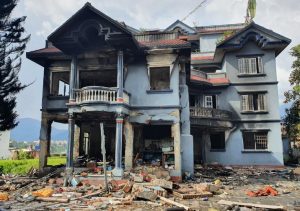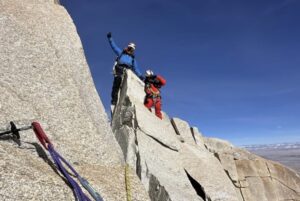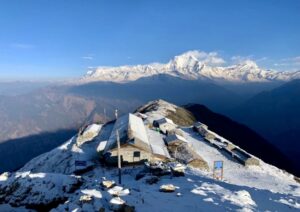In Nepal, there are 86 peaks (including sub-peaks) between 7,000, and 7,999m. Some of them haven’t been climbed for years. Today, we examine the climbing history of 7,455m Gangapurna.
Gangapurna
Gangapurna lies in the Annapurna range of Nepal’s Gandaki province and connects Annapurna I and Annapurna III.
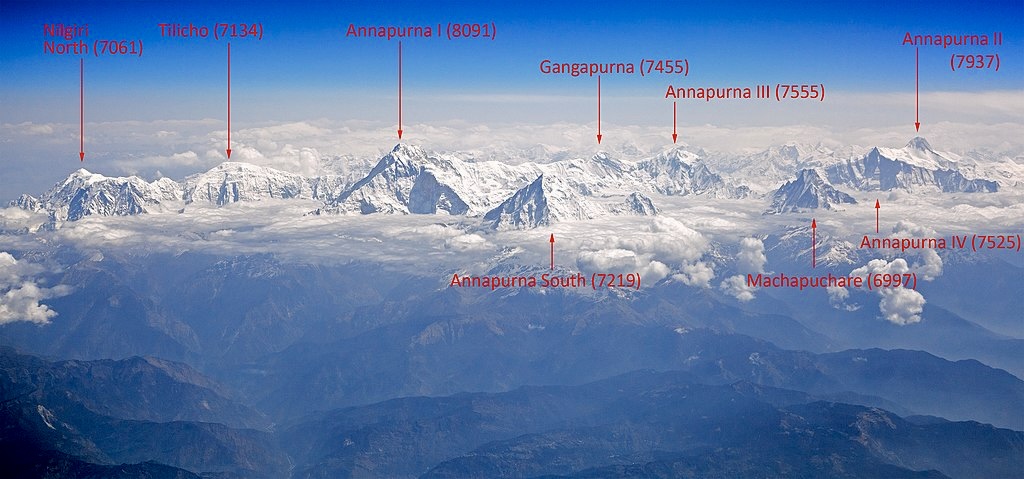
Photo: Solundir
In Sanskrit, Ganga refers to the Ganga goddess (the personification of the River Ganges) in Hindu mythology, and purna means “filled with.” The name can be translated as “the Goddess that brings water.”
Until the end of 2023, 29 expeditions had targeted Gangapurna. Forty-one climbers have summited it, all without supplemental oxygen.
The last successful ascent was in the autumn of 2016. Since then, four teams have made unsuccessful attempts, most recently in 2022.
Eleven climbers have died on this 7,000’er, including eight who perished on the same expedition.

Photo: Google Earth
The first ascent
Gangapurna’s first ascent came on the very first attempt.
The German Alpine Association Gangapurna Expedition led by Gunther Hauser established Base Camp at 3,750m on April 6, 1965. The party included nine Germans and three Sherpas.
The team ascended by the east ridge from the south. They told The Himalayan Database that the climb was harder than they expected. The crux was a 400m ice wall that led to a col, where they had to fix ropes. The face below Annapurna III and Gangapurma was steep, with large ice towers at the top.
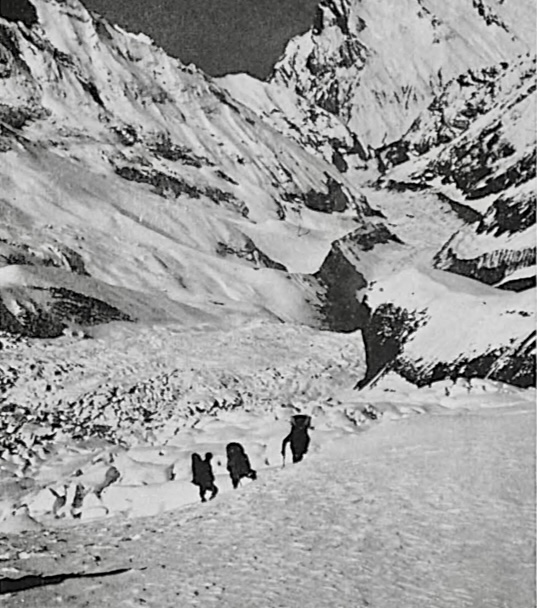
Gangapurna, between Camp 2 and Camp 3 in the icefall. Photo: Alpine Journal
The Germans summited in two groups. Gunther Hauser, Ludwig Greissl, Hermann Kollensperger, Erich Reismuller, Ang Temba Sherpa, and Phu Dorje Sherpa topped out first on May 6. Herbert Wunsche, Otto Seibold, Karl Heinz Ehlers, Klaus Ekkerlein, and Pemba Norbu Sherpa followed two days later, on May 8.
Hauser’s team also summited two other peaks: 7,168m Glacier Dome and 5,695m Tharpu Chuli (also known as Tent Peak). These were the second ascents of each peak, which Japanese climbers first summited in 1964.

The east ridge of Gangapurna. Photo: The Alpine Journal
Other routes
The 41 mountaineers who summited Gangapurna belonged to nine different expeditions. Thus, only nine of the 29 teams that attempted Gangapurna succeeded.
The nine teams did not all follow the first ascent route (east ridge from the south). Other routes included the west ridge from the south (ascended for the first time in 1971), the south face route (ascended first in 1981), the north face to the northeast ridge route (ascended first in 1983), and the east ridge route (ascended first in 1985).

Gangapurna from the south, showing the 1965 route. Photo: Alpine Journal
Accidents
The most tragic Gangapurna expedition was in the autumn of 1971. The Nagano Mountaineering Association from Japan, led by Kiyoshi Shimizu, chose the west ridge and approached the mountain via Modi Khola.
According to their report for The Himalayan Database, Shimizu, Takeshi Akahane, and Girme Dorje Sherpa reached the summit on October 15 at 2:15 pm. By 7 pm, they had returned to Camp 4 at 7,120m, where a second summit team of four climbers was waiting.
The three summiters had planned to continue down to Camp 3 (at 6,850m), where three more teammates were waiting to support the two summit teams. However, heavy snow pinned all seven climbers in Camp 4.
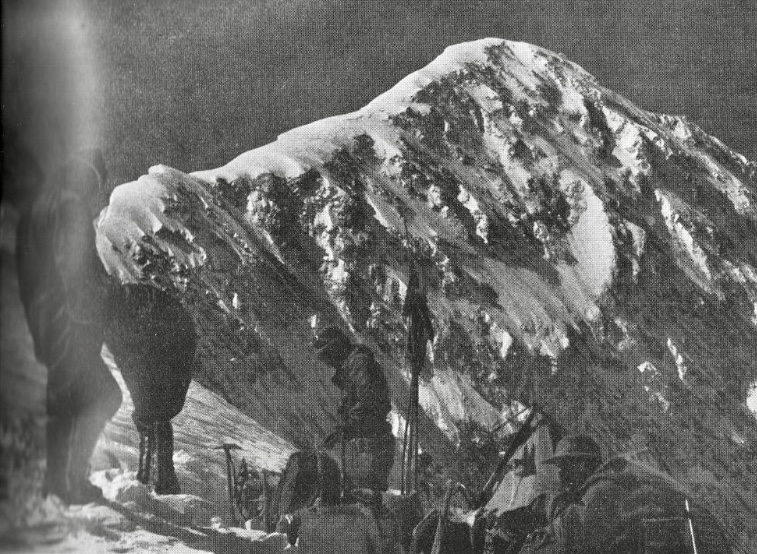
The north face of Gangapurna from Camp 3 (6,750m). Photo: The Himalayan Club
On the afternoon of October 16, the higher camps failed to make radio contact with Camp 2. Three Japanese climbers and three Sherpas supposedly waited there.
On October 17, Girme Dorje Sherpa and Pemba Norbu Sherpa went down to investigate. On October 18, they reported that Camp 2 had completely disappeared, presumably swept away by an avalanche a day earlier. The avalanche likely killed all six climbers there.
After the grim discovery, Girme and Pemba returned to Camp 3, although their Japanese teammates warned them to continue down because of the avalanche risk. Girme and Pemba never arrived. Either an avalanche swept them away, or they fell into a crevasse. The expedition ended with eight deaths.
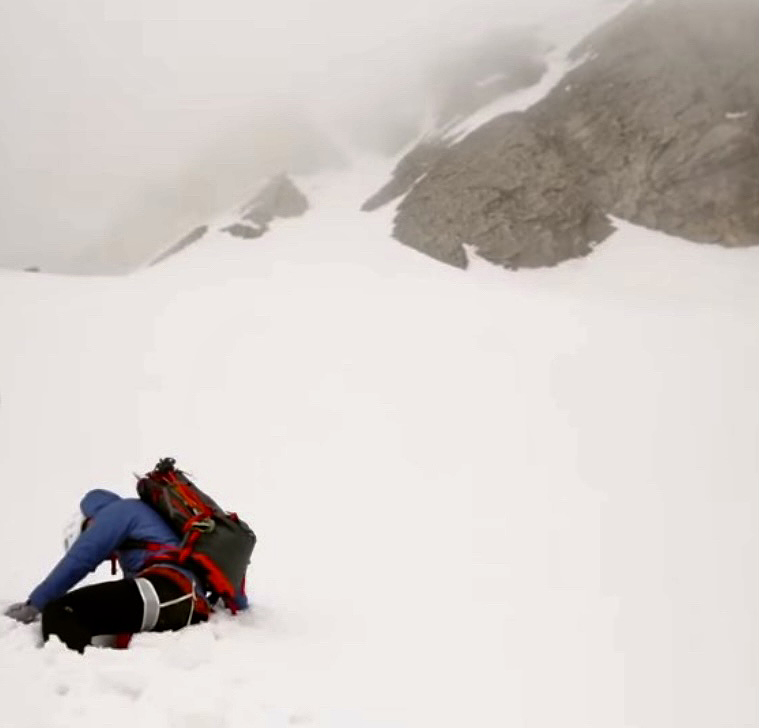
Jonatan Garcia swims through deep snow in 2022. Photo: Topo Mena
More fatalities
Another fatality occurred on a Japanese expedition in the autumn of 1981. The Meiji University Sunday Alpine Club Gangapurna Expedition, led by Yuichi Suzuki, targeted the northwest ridge-northeast ridge route. They abandoned their attempt on September 26 at 7,000m after an avalanche killed Takeshi Sakamoto and Akira Suzuki.
In the spring of 2009, an Iranian party led by Hamid Hajarian attempted Gangapurna by the east ridge from the north. The expedition ended at 6,100m when liaison officer Deepak Prasai died at 3,900m from Acute Mountain Sickness.
Notable ascents on the south face
In the spring of 1981, Canadian John Lauchlan led a successful expedition to the south face. The party included James Blench, Dwayne Congdon, and Dave McNab.
Lauchland, Blench, Congdon, and McNab had been partners for three years and were close friends.
“We had learned to resolve our problems effectively,” Lauchland wrote. “Four individuals with differing expectations, different amounts of drive but the same vehicle for expression and exploration — on a new route on the south face of Gangapurna.”
The Canadians climbed the south face more or less in alpine style. Blench and Lauchlan summited on April 30 at 3 pm. It was a remarkable ascent for the era.
The American Alpine Journal noted that the climbers faced bad weather and technical climbing on 80º ice and mixed rock. Blench and Lauchlan summited amid a lightning storm after solving the snowy face.
The following day, Blench was very sick. Lauchlan spent two days lowering Blench down to the bergschrund, where they met Congdon and McNab. All the team members suffered frostnipped toes.
The most recent summit
The most recent summit was in the autumn of 2016 by a small South Korean party led by Kim Chang-ho.
An extremely strong alpinist, Kim Chang-ho made bold, lightweight alpine-style ascents. In 2013, he became the first Korean to climb all 14×8,000m peaks without bottled oxygen. He completed the feat in just seven years, ten months, and six days — a record at the time.
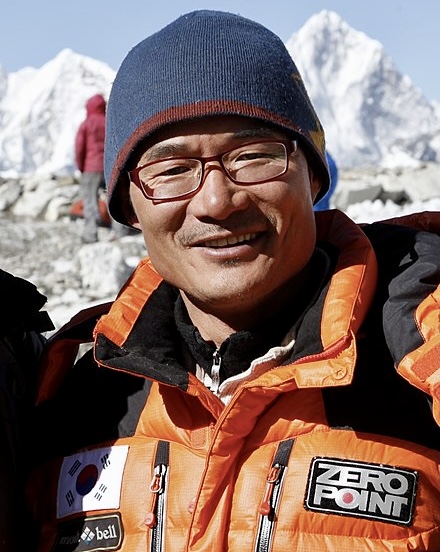
Kim Chang-ho. Photo: Wikipedia
After completing all the 8,000m peaks without supplemental oxygen, a question lingered in Chang-ho’s mind: What to do next?
“Like everyone else, I don’t have a compass that keeps me directed on the right line to follow,” he wrote in the American Alpine Journal. “So, I thought about my lifelong passion for authenticity in the spirit of mountaineering. This spirit taught me principles: to overcome one’s limits, to pursue uncertainty, and to explore beyond the end of the road.”
Keeping these in mind, he devised the Korean Way Project. He aimed to create natural lines on unclimbed peaks and walls with no extra equipment. In 2016, he organized a small team to climb the Gangapurna’s south face by a direct line to the right of the Canadian route.

South Korean climbers in 2016. Photo: Kim Chang-ho
Chang-ho invited two more South Korean climbers: Choi Seok-mun and Park Joung-yong. They climbed a direct route on the south face between October 16 and 22, topping out on October 20. They named their line the Korean Way.
Gangapurna West attempt
During that expedition (before their Gangapurna south wall ascent) Chang-ho’s team also attempted the south face of unclimbed 7,140m Gangapurna West. This secondary peak west of Gangapurna opened for climbers in 2014. They reached 7,040m but turned around 100m below the summit on October 8.
Another attempt on Gangapurna West was made in the autumn of 2017. Italians Simon Messner and Philipp Pruenster tried its north face but abandoned it at 6,200m after losing tents and equipment.
The only other attempt on Gangapurna West was by a U.S. team in 2019. Led by Jason Kolaczkowski, the seven-person team climbed the southeast spur and reached 6,200m before aborting due to illness and injuries.
Gangapurna West remains unclimbed.
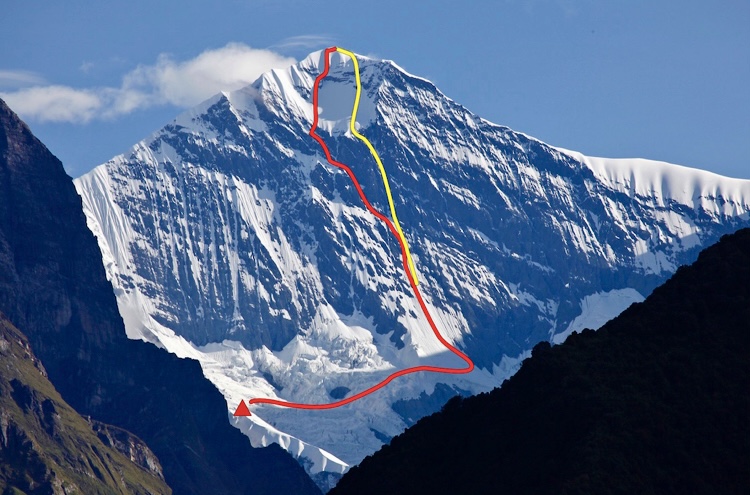
The Korean Way on the South Face of Gangapurna. Photo: Kim Chang-ho
The last attempt on Gangapurna
Gangapurna was last attempted in the spring of 2022 by Topo Mena of Ecuador and Jonatan Garcia of Spain. They tried the south face, but deep snow forced them to abandon the attempt at 5,400m.
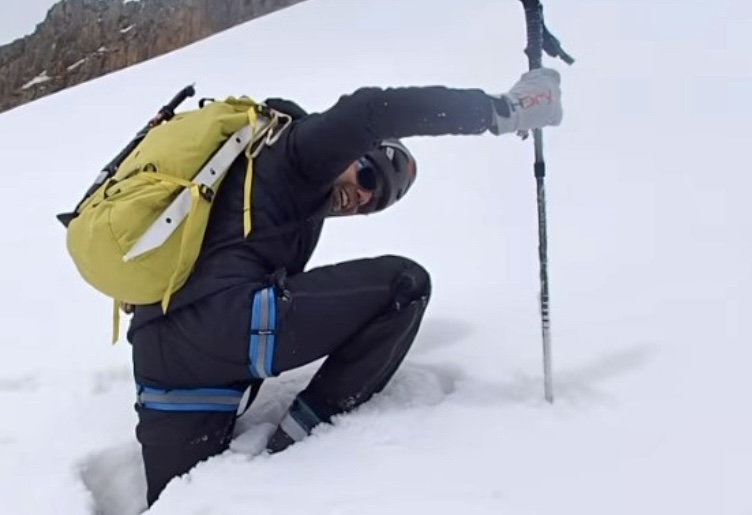
Topo Mena postholes through deep snow on Gangapurna. Photo: Jonatan Garcia

